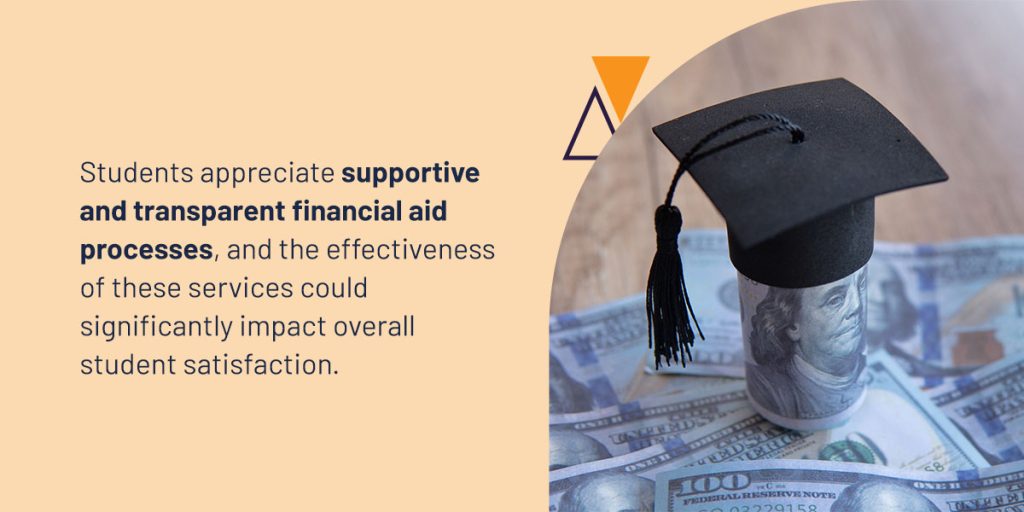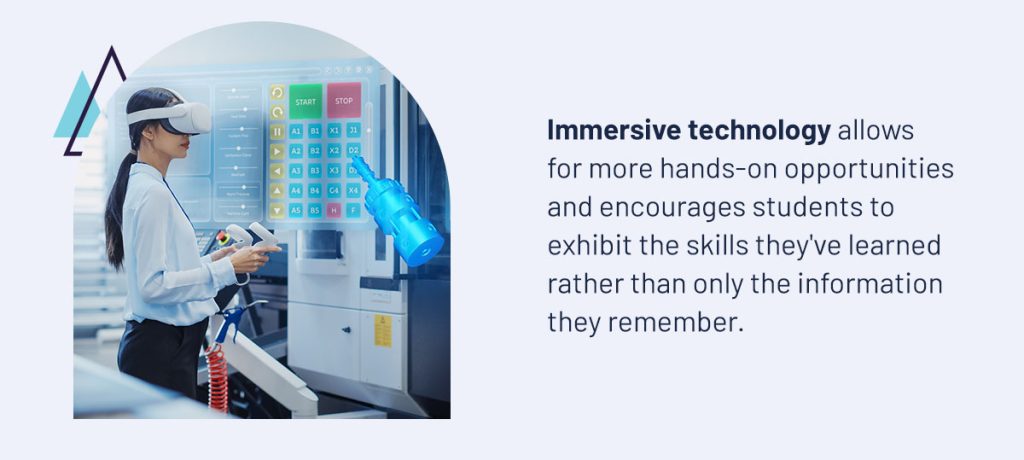




Improving student satisfaction can benefit your institution immensely. When your students feel satisfied with their experience and education, they’re more likely to remain engaged in the curriculum, finish their programs, and reach graduation.
High levels of student satisfaction can help you reach campus initiatives and drive change at your institution. Here are nine tips that discuss how to improve student satisfaction in higher education institutions.
Student satisfaction depicts student feelings and attitudes toward their higher education institution and education. Students use the experience on campus and the services, programs, facilities, and resources they can access to determine the value they’re receiving from their college or university. If we break these factors down even more, they would consist of characteristics like:
Understanding the quality of each student’s experience at your institution is essential for creating new initiatives and strategies to boost satisfaction. Satisfaction plays a significant role in educational outcomes, which means high satisfaction rates can benefit your institution by aiding in retention, enrollment, and more.
Student satisfaction is a huge part of the learning process. Your students pay lots of money to receive a high-quality education, and they deserve to feel like that money is going to good use. In this case, “high-quality education” encompasses more than just the knowledge that will drive them toward their future career — it’s everything your institution offers, including:

Students who spend lots of time on campus, have adequate financial support for loans, and are pleased with their professors are more likely to feel good about their school choice. No matter how prestigious your institution is, poor student satisfaction reports will negatively impact how the outside world views your school’s character, effectiveness, and value. Student satisfaction ratings are regularly used as higher education performance indicators, reflecting the quality of your holistic education experience. When these ratings go down, students are more likely to transfer to another institution, drop out, or avoid your institution altogether, making it challenging to reach campus initiatives and set new goals.
Before taking steps to foster student satisfaction, you must understand how to gauge current levels of satisfaction and which areas need improvement. Gathering data can ensure you dedicate the proper resources and time to driving the change your students want to see on campus. It is also important to gauge the effectiveness of your initiatives as you make changes. Assessing strategy performance will allow you to determine where to make additional adjustments and whether you’re on the right track.
Gathering direct feedback from your students through detailed course critiques and surveys is an excellent way to determine what areas need your immediate attention. Your students already know what they want to see on your campus and in the classroom, so questionaries and feedback opportunities are a great way to discover game-changing insights. For example, course evaluations can depict whether teaching methods are effective, how many students utilize class resources, and more. These evaluations have additional benefits for students, such as prompting self-reflection and empowering students to take an active role in their education by sharing their voices.
You can also measure student satisfaction by:
There are many things higher education institutions can do to improve student satisfaction. Some of these tips may be a matter of adjusting practices you currently have in place, while others may be new steps you can take to boost student responses and engagement.
While it’s vital to give student satisfaction a boost for you and your students, you don’t want to treat them like paying customers by always giving them exactly what they want instead of what they need for success. Educators should strive to satisfy their needs while providing them with the learning outcomes and resources they require to graduate and enter the workforce.
Check out these nine tips to improve student satisfaction in meaningful ways.
Many campus initiatives aim to boost student engagement and benefit your campus, but some are more student-directed than others. Putting a focus on student well-being can positively impact their experiences on campus. You can think outside the box to develop new initiatives that stand out to your students and the community. Ideas include:
Students venture to your campus from all walks of life, and you must do your best to satisfy all their needs, including ethnically diverse and low-income students who fall in the minority. These students can face debilitating issues like discrimination, hate crimes, bullying, and racial harassment on campus, which can significantly impact their academic experiences.
Focus on deciding what resources and tools your campus has to guide these students to success. Fostering a safe, welcoming, and inclusive institution will benefit every student. You can expect student satisfaction to increase when you reduce harmful actions and boost efforts to deliver student support and foster a sense of well-being and belonging.
Students face many challenges within the bounds of campus and beyond. Offering high-quality support services will help learners attain the assistance they need to succeed academically and in every other facet of life. These resources extend past typical writing and tutoring centers commonly offered at all colleges and include services like:
Work alongside students to review and co-develop the curriculum. Use their feedback to tailor courses and ensure every assessment, assignment, and learning module adds value to your student’s education. Using student feedback will be vital during this stage, as you will want to make changes that positively influence their experiences.
Using feedback can help you ensure students have the resources they need to succeed and promote a positive campus culture, leading to improved student engagement that will connect students with their studies and peers. With their surveys and evaluations, you can determine whether to adjust teaching practices, reconsider the number of quizzes and exams throughout the semester, adjust curriculum credits, and so much more.
One of the easiest ways to foster student satisfaction is by asking students directly. A college student satisfaction survey gives students a voice and lets them describe the changes they want to see on campus. Gather a complete picture of student engagement and satisfaction by examining qualitative and quantitative data. You can take their thoughts and opinions and turn data into action.
One-size-fits-all student surveys typically ask only for information such as teacher performance and course content rather than areas to improve. It’s crucial to offer open-ended opportunities for students to voice their opinions, such as interviews, focus groups, and unrestricted questionnaires. These platforms will allow students to voice their concerns while you show them you care about their experience and prioritize taking steps to improve it in any way you can.
Once you have enough data, you can formulate a strategy to target areas of concern to increase student satisfaction rates.

Innovative technologies can transform courses and academic programs. Technology is a prominent feature in every industry to some extent, so it’s essential for students to interact with the equipment and technologies they may see in their careers. Immersive technology allows for more hands-on opportunities and encourages students to exhibit the skills they’ve learned rather than only the information they remember. Whether you invest in new lab equipment, integrate new computers on campus, or find ways to incorporate virtual reality learning opportunities, there are many ways to embrace innovation and bring exciting experiences to the classroom.
Updated amenities can go a long way to highlight your campus as caring and improve student satisfaction in higher ed. Some popular amenities that many students enjoy include fitness centers, recreational centers, study spaces, dining options, and clubhouse or community social spaces.
You can also improve student satisfaction by updating some often neglected amenities. For example, you can transform the mailroom experience by implementing lockers to reduce stress related to picking up a package by a certain time or theft in community buildings.
You can also update laundry facilities. Ensure washers and dryers are up-to-date and operate efficiently. Keeping these spaces clean can also encourage more use, and implementing some security measures such as keycards or passcodes can reduce potential traffic so students feel more comfortable leaving the room while the machines run.
If your campus allows pets, consider adding or updating pet-friendly spaces. A small area for dogs to run can encourage students to spend more time on campus with their furry friends. You could consider adding tables or benches so students can relax, eat a small meal, or study while their pets release energy.
The amenities you update or add should reflect student needs. Gather student feedback and consider what neighboring institutions offer that could improve the campus experience of your students.
Although in-person classes offer immense value for many students, there are also amazing opportunities to find through online courses or digital course materials. For some students, opting for a digital class could reduce the stress associated with commuting to campus or conflicting with other responsibilities. Even on the simple side, digital course materials can ensure students always have access to the information they need whenever they need it. For example, if a student travels for the weekend, they won’t need to stress about leaving behind a textbook if they can easily access the material online.
Traditional on-campus classes can also offer various digital opportunities to give students a small break from the routine hustle and bustle. For example, educators could record some class lessons and make them available online. This strategy could be beneficial during busy times of the year, such as during midterms or finals, or when the weather may be less than ideal for traveling. This option allows students to participate in class virtually so they don’t miss essential information.
A student’s first year is crucial. Although each year brings immense value to a student’s goals and aligns them with their career path, the first year can be a make-or-break experience for many. Students are often branching out on their own for the first time in their lives. New students typically encounter challenges, such as making new friends, being away from their families, and taking risks. Proper support and reliable resources can help students develop healthy coping strategies and boost their mental health, improving their happiness and satisfaction.
There are several ways you can transform and enhance the first-year experience to set students on the right track from day one. Creating a mentorship program, providing resources, and offering experience classes are simple ways to encourage more student participation and align students with their new support system. You can also boost satisfaction by crafting class schedules that reflect student interests, needs, and wants to show each student that you support their dreams and goals. All of these actions can play a significant role in showing your students that you care about their well-being, mental health, academic careers, and future career paths after graduation.
Watermark enables higher education institutions to drive change and guide students to success. We empower colleges and higher education institutions to support meaningful data collection, measurement, and review. With Watermark Course Evaluations & Surveys, you can easily distribute assessments and review meaningful student data to drive change at your institution. Working with Watermark Curriculum Strategy, you can transform your courses to meet student needs.
Improving student satisfaction can be simple with the right tools, like the ones we’ve crafted at Watermark. Request a demo of our solutions and boost student satisfaction.
Watermark empowers higher education institutions to collect data and gain valuable insights to improve student outcomes. Our solutions help maximize educational impact and streamline processes so you can focus on what really matters — your students. We aim to help you drive success for your community and institution. With more than two decades of experience helping colleges and universities, we feel confident that we can help you transform your institutional processes to boost student satisfaction and outcomes.






























































































































































































































































































































































































Submit this form to schedule a meeting with one of our reps to learn more about our solutions. If you need customer support instead, click here.